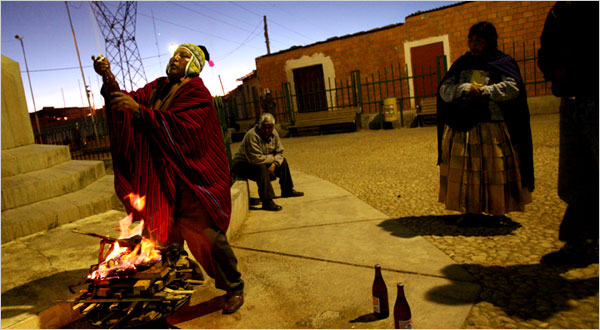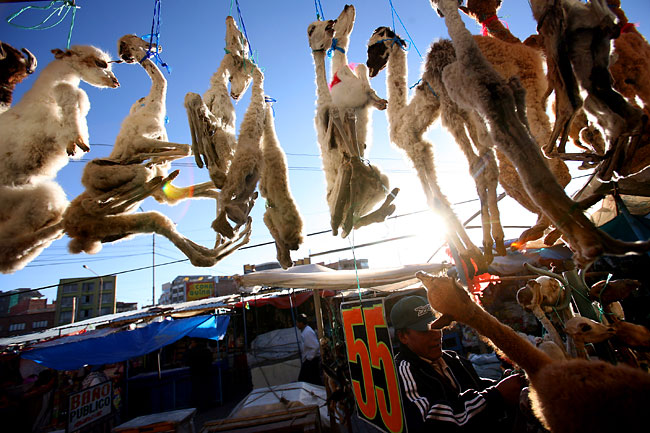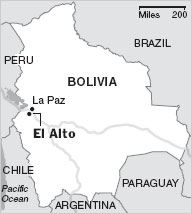 (above) Domingo Arcani, left, performed a ritual offering to the Pachamama, or Mother Earth, last Friday in El Alto, Bolivia. (Photo: Noah Friedman-Rudovsky for The New York Times)
(above) Domingo Arcani, left, performed a ritual offering to the Pachamama, or Mother Earth, last Friday in El Alto, Bolivia. (Photo: Noah Friedman-Rudovsky for The New York Times)
A Month to Conjure Luck With Sacrifices in Fire
August 20, 2008 - New York Times
By SIMON ROMERO
EL ALTO, Bolivia -- Huddled near one stall selling more than a dozen llama fetuses, another hawking porcupine tails and yet another offering bottles of homemade singani, the dangerously potent Bolivian liquor distilled from the muscatel grape, Ponciano Janco motioned to come just a little bit closer.
"I have something for you," said Mr. Janco, 45, dipping his hand into a burlap sack to produce a live armadillo about the size of a rugby ball. Both the armadillo and Mr. Janco’s potential customer shivered as an icy wind whipped through the witch’s market here in this sprawling city of slums some 13,600 feet above sea level.
For just 50 bolivianos, about $7, Mr. Janco said he could perform a ritual involving the armadillo that would leave his customer better prepared for the vagaries of life in the year ahead. "It is a meager price to pay for good fortune," he added.

(above) Llama and vicuña fetuses are sold at the witch’s market in El Alto for rituals seeking good fortune as spring arrives. (Photo: Noah Friedman-Rudovsky for The New York Times)
With farmers hoping for healthy crops and urban dwellers searching for blessings in one of South America’s poorest countries, no month beats August for the yatiris (pronounced yah-TEE-rees), specialists in divining good luck who sell their services along Avenida Panoramica in El Alto.
As a time of transition from winter to spring in the regional agricultural calendar, August is the period when the earth and mountain deities are said to be especially hungry, according to scholars who study the culture of the Aymara, the indigenous group that makes up a majority of El Alto’s population of about 800,000.

(left) El Alto is a high-altitude twin city to La Paz, the capital.
Feeding the Pachamama, whom the Aymara also call Mother Earth or Mother Virgin, involves an intricate web of symbolic gestures incorporating coca leaves, bootleg spirits and dead animals, preferably in the form of fetuses when it comes to llamas, pigs, cats and dogs.
"Although the timing of the offerings can be pinned to a traditional rural agricultural calendar, it is important to remember that these sorts of offerings can in fact address very contemporary urban and rural concerns," said Andrew Orta, an anthropologist at the University of Illinois at Urbana-Champaign, who specializes in the Bolivian highlands.
Beyond the yatiris and the hawking cries of the saleswomen, the market points to a thriving urban culture. Next to a stall selling fox and mountain lion hides and another specializing in pig fetuses, Miguel Miranda blared the rap music of Rimadores Locos, an El Alto-based band that performs in a hybrid of Aymara and Spanish.
"August is also my best month to sell CDs," said Mr. Miranda, 25, in front of his music booth. "Someone walks by looking for a llama fetus, or maybe the hide of a skunk, but if they’re young they might want a little music as well."
Once the requisite ingredients are sold by vendors in the witch’s market, the yatiris gather them into what they call a misa. The word is the same as the Spanish term for Mass, but linguists say it also may be an Aymarization of another Spanish word, mesa, or table.
Placing the fetuses and other items on a plate, the yatiris then set it on a table of coals to burn. Up and down Avenida Panoramica, and into a maze of nearby side streets, the smoke from the offerings mixes with the smell of sewage seeping into the bare ground. The yatiris toss pure alcohol or beer on the small pyres, causing flames to leap in the cold air or subside.
Once the items are consumed by fire, the yatiris generally bury what remains in the soil, thus feeding the earth as springtime -- or what passes for springtime on these frigid high plains -- approaches.
Reflecting a fusion of rural and urban customs, the customers for these offerings aspire to a variety of hopes, from abundant crops, success in studies, an accident-free year for truck drivers or vibrant sales for the industrial factories or textile manufacturers that have recently sprung up here.
A sign on the door of the small shack of one yatiri, Jorge Sharon, summed it up thusly: "For love, travel, marriage, health, legal problems, making lost things appear, duty inspections, exams at the teacher’s college."
The recipes for good fortune are equally broad. A deer fetus, for instance, offers luck for tin miners who descend into the bellies of mountains. For a love triangle, the yatiris recommend the fetuses of a dog and a cat, the idea being that an illicit affair can come undone if the lovers fight like cats and dogs.
Then there are the items employed to address financial concerns, big and small.
"The rich guys from La Paz drive up here for the vicuña fetus," said one saleswoman, Nina Quispe, 28, referring to an endangered animal usually banned from the relatively sanitized witch’s market in the capital, La Paz. A vicuña fetus, she said, is the most expensive item in the market, running 800 bolivianos, about $117.
Functioning as kind of a twin city to La Paz below it, El Alto was settled by veterans of the astoundingly bloody Chaco War of the 1930s and later by miners expelled from their jobs after cutbacks at state companies in the 1980s.
Then immigrants from throughout the highlands poured in, expanding its network of cinderblock and adobe hovels. Political activism became fused into El Alto’s identity.
By blockading roads and sealing off access to the nearby international airport, "For simple geographic reasons, protesters from El Alto were able to besiege La Paz," said Sian Lazar, author of "El Alto, Rebel City," a new book about the city’s growing political power.
Evo Morales, a former llama herder who rose to the presidency thanks in part to the support of El Alto’s protesters, sometimes has yatiris accompany him to political events. Photos of Mr. Morales, the first Bolivian president to explicitly identify with his indigenous roots, could be found up and down Avenida Panoramica on a recent Saturday.
But even Bolivia’s vibrant politics seemed eclipsed by other concerns for the customers shopping at the market’s stalls. "I’m looking for something that will help a fellow countryman on a voyage of emigration," said Fernando Sinani, 34. "What do you need for someone who is about to set out across the sea?"